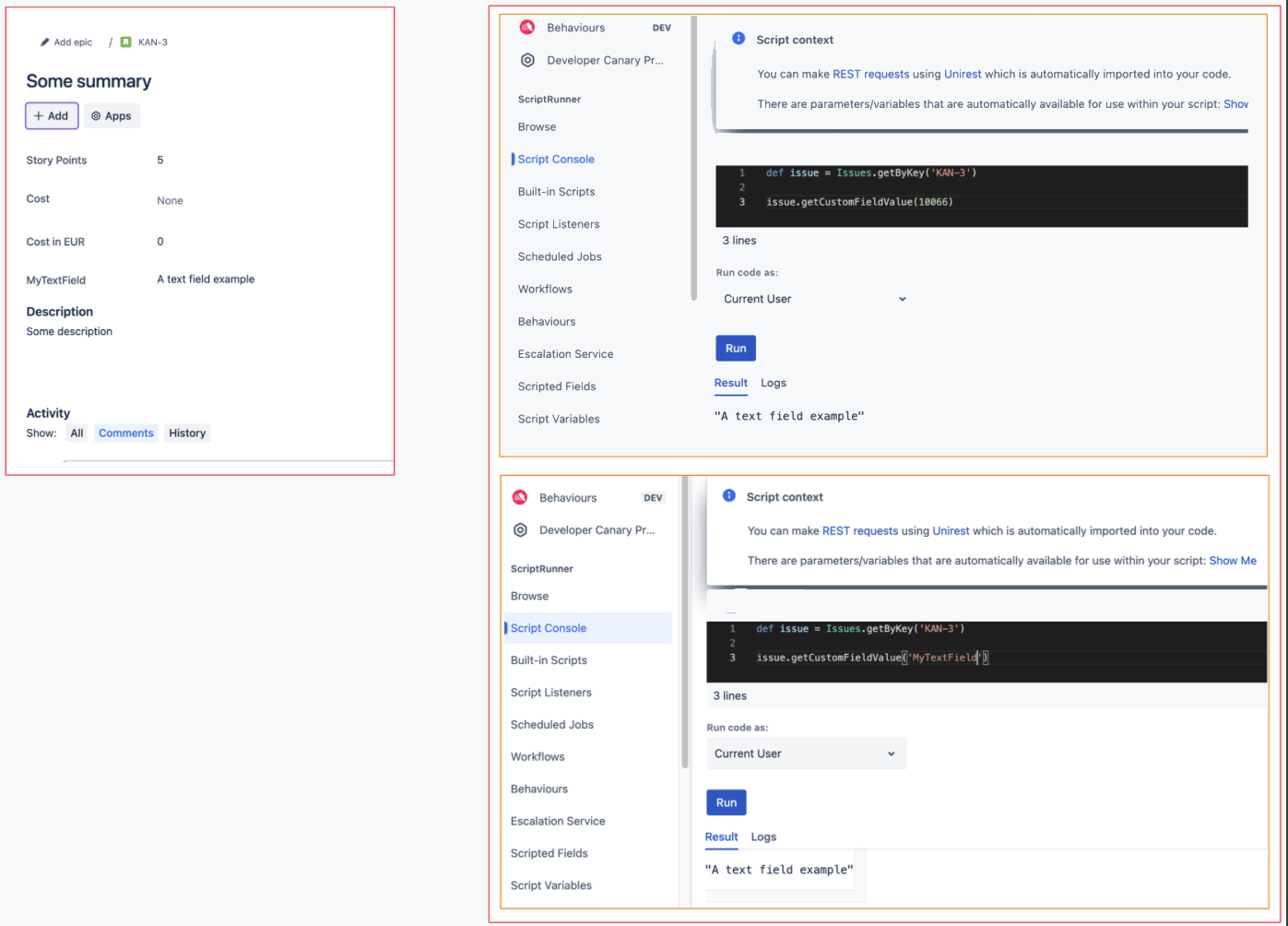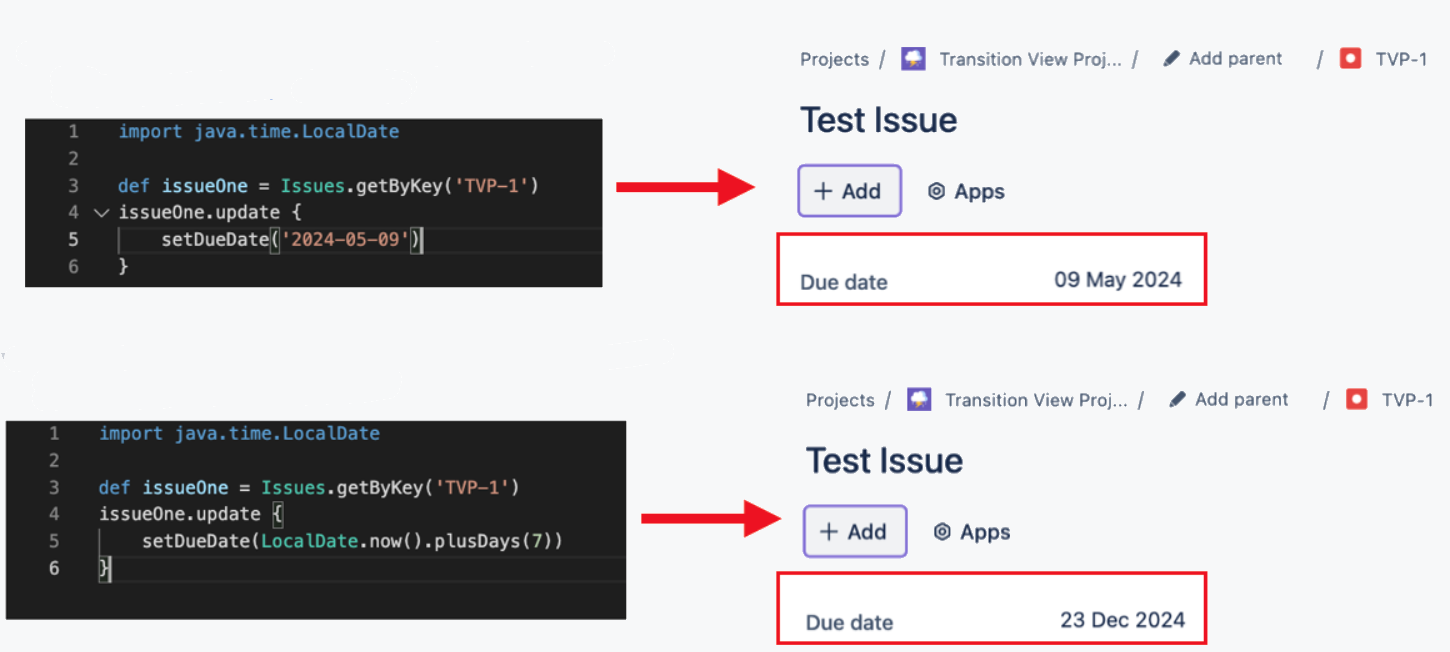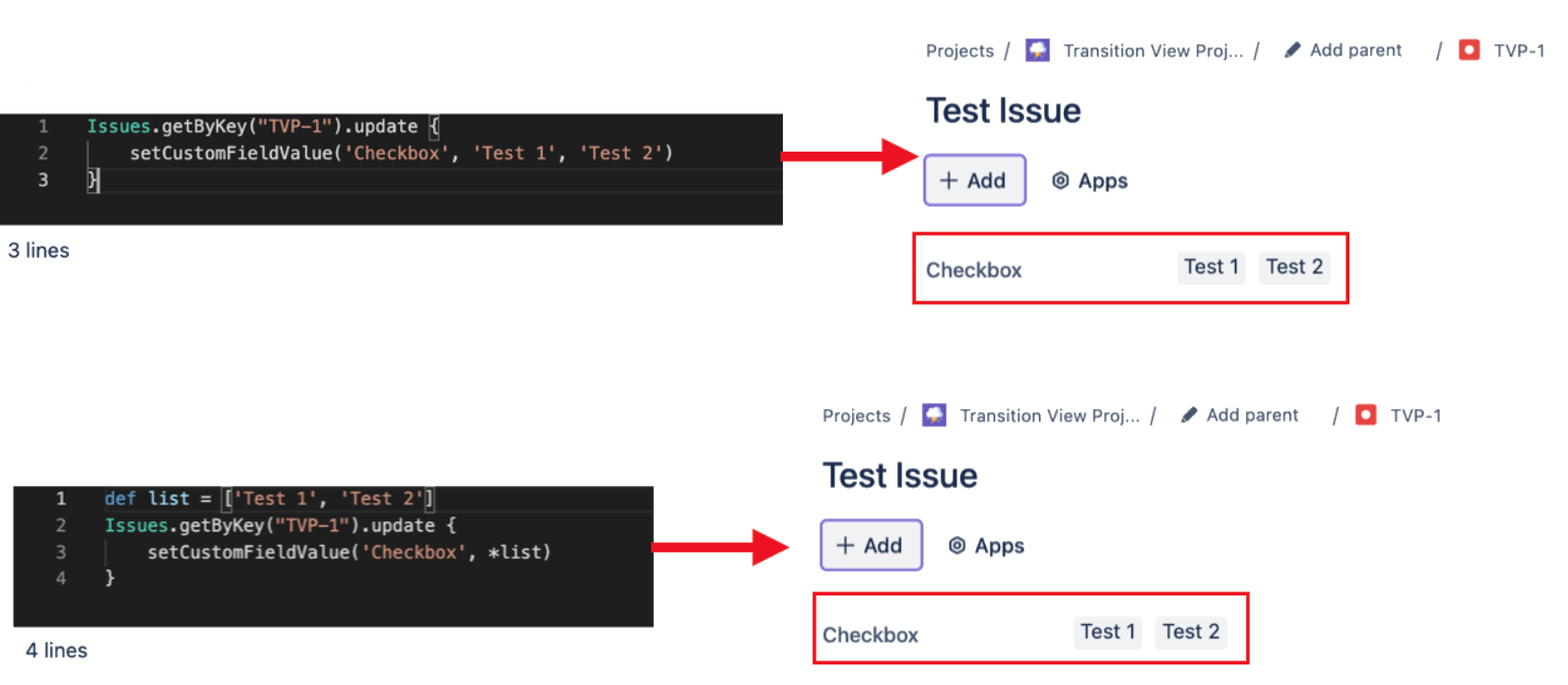Update Fields
Updating custom fields is a very common task. There are three ways to specify custom field values:
- Use textual names for fields, for readable and simple code. For example, for a select list you specify the option value.
- Use object IDs if you feel concerned about names changing. For instance, in a select list you can use an option ID.
- Use the underlying objects (
Option,Version) - this is useful when copying values from one issue to another.
We also cater for common automation tasks, such as setting an additional fix version or multi-select value without retrieving the current value, adding the new one, and then setting the new list of values.
Custom fields can be set by numeric ID or name. The numeric ID of a custom field is just the number portion of its ID. For example, if the String ID is customfield_12345, the numeric ID is 12345. Use the custom field name for readable and portable scripts. To read the value of a custom field, see the Reading Custom Field Values section below.
Using the ID
We recommend that you use the ID if you plan to rename your custom fields or have multiple fields of the same name.
Read the value of custom fields
You can use the HAPI shortcut to get custom field
groovy// by custom field name issue.getCustomFieldValue('My text field') // or by custom field ID issue.getCustomFieldValue(10146)
Using this shortcut means you don't have to use CustomFieldManager to look up the custom field instance first.
Caching
It's important to note that an issue's fields are cached when the Issue object is first retrieved. Therefore, if you retrieve a custom field value and then update the field, whatever the value was before you updated the field is returned. To ensure the updated value is returned you can use refresh().
For example, the following logs out null rather than the updated value:
groovydef issue = Issues.getByKey('JRA-1') logger.warn(issue.getCustomFieldValue('Select List').toString()) issue.update { setCustomFieldValue('Select List', 'First Option') } logger.warn(issue.getCustomFieldValue('Select List').toString()
If we add refresh() to the Issue object it returns the expected result of First Option:
groovylogger.warn(issue.refresh().getCustomFieldValue('Select List').toString())
Update text fields
In this example we're using custom field values to add a text field to the issue. Text fields can be set using the following:
groovyissue.update { setCustomFieldValue('My text field', 'foo') } //or issue.update { setCustomFieldValue(10104, 'foo') }
Bulk update text fields
In this example you are working on a product, and you changed its name in the early stages of development. Now you wish to edit the name in the description of all issues. You can use a JQL query to bulk update fields, as shown below:
groovyIssues.search('project = KAN and description ~ hello').each { issue -> issue.update { setDescription('goodbye') } }
Update date and date time fields
In this example we're setting the due date. Date system fields, such as due date and Date Picker custom fields, can be set as follows:
groovyimport java.time.LocalDate def issueOne = Issues.getByKey('JRA-1') def issueTwo = Issues.getByKey('JRA-2') issueOne.update { setDueDate('2024-11-27') // additionally you can use a LocalDate, e.g. for copying from another issue setDueDate(issueTwo.getDueDate().toLocalDate()) // or use a LocalDate object, for instance to set the date to 7 days from now setDueDate(LocalDate.now().plusDays(7)) }
Set a single value
In this example we're setting a single radio button field. To set a single value (radio-buttons, and single-select custom fields):
groovyissue.update { setCustomFieldValue('My radio buttons', 'Yes') }
Set multiple values
In this example we're setting multiple checkbox fields. You can set multiple values as follows:
groovyissue.update { setCustomFieldValue('My checkboxes', 'Yes', 'Maybe') }
You can also use the Groovy spread operator to list multiple values. The spread operator (*) allows you to pass elements of a collection as individual arguments to a method. This is particularly useful when you have a list of values. For example:
groovydef issue = Issues.getByKey('JRA-1') def list = ['Yes', 'Maybe'] issue.update { setCustomFieldValue('My checkboxes', *list) }
Add to an existing selected option
In this example we're adding an additional checkbox value and adding a fix version. You can add an existing selected option using add(). This is also valid on other fields that are a "collection" of object; for example affects/fix versions and components:
groovyissue.update { setCustomFieldValue('My checkboxes') { add('Maybe') } setFixVersions { add('v2.0') } }
Remove a selected value
In this example we're removing the No checkbox value. You can remove a selected value if it is present:
groovyissue.update { setCustomFieldValue('My checkboxes') { remove('No') } }
Set values by option Name
In this example we're setting the checkbox 'Yes' and 'Maybe' values by their name. The add, remove, and replace methods have overloads which let you set the "object" rather than the textual name. For example Version, Option, or the object's name.
To set by option name:
groovyissue.update { setCustomFieldValue('My checkboxes') { set('Yes', 'No') } }









